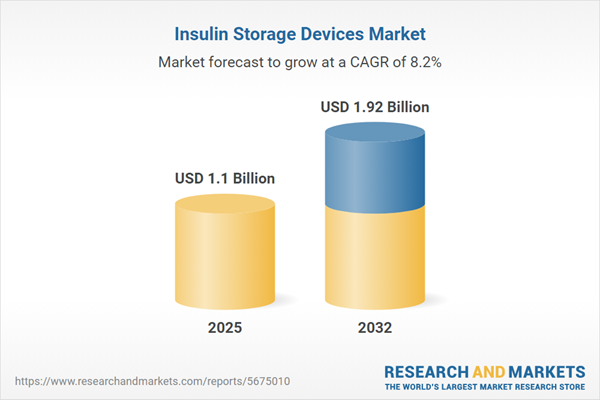Speak directly to the analyst to clarify any post sales queries you may have.
The insulin storage devices market is evolving rapidly as healthcare decision-makers seek reliable solutions to safeguard product efficacy across increasingly complex supply chains. This report distills actionable insights from the world’s leading research on the insulin storage ecosystem, serving the strategic interests of senior executives in medtech, pharma, logistics, and procurement.
Market Snapshot: Insulin Storage Devices Market Size & Growth Trajectory
The Insulin Storage Devices Market grew from USD 1.02 billion in 2024 to USD 1.10 billion in 2025. It is expected to maintain robust momentum, expanding at a CAGR of 8.23% and reaching USD 1.92 billion by 2032. Market expansion is underpinned by greater regulatory focus, rising diabetes prevalence, and increasing demand for both advanced active storage systems and cost-efficient passive solutions.
Scope & Segmentation of the Insulin Storage Devices Market
This research provides a detailed breakdown of the insulin storage solutions ecosystem, covering product innovations, operational models, technologies, end-users, and market channels across key global regions.
- Product Types: Battery-powered coolers, electric refrigerated units, cooler boxes, foam containers, insulated bags, Bluetooth temperature monitors, IoT-enabled refrigerators, integrated monitoring solutions, standalone data loggers.
- Modes of Operation: Electric cooling, thermoelectric cooling, dry ice-based, gel pack-based, phase change material-based systems.
- Technologies: Compressor cooling, thermoelectric solutions, gel pack systems, IoT-enabled monitoring (cloud platforms, mobile app integration), phase change materials.
- End Users: Home users, private clinics, public hospitals, hospital pharmacies, retail pharmacies, research laboratories.
- Distribution Channels: Hospital channels, medical device distributors, pharmacy outlets, e-commerce platforms, manufacturer websites.
- Geographies: Americas (including the United States, Canada, Mexico, Brazil, Argentina, Chile, Colombia, Peru), Europe (including the United Kingdom, Germany, France, Russia, Italy, Spain, Netherlands, Sweden, Poland, Switzerland), Middle East (United Arab Emirates, Saudi Arabia, Qatar, Turkey, Israel), Africa (South Africa, Nigeria, Egypt, Kenya), Asia-Pacific (China, India, Japan, Australia, South Korea, Indonesia, Thailand, Malaysia, Singapore, Taiwan).
Key Takeaways for Senior Decision-Makers
- Digital transformation is accelerating, with IoT-based monitoring and cloud analytics increasingly embedded in both active and passive insulin storage devices, enabling real-time oversight and predictive maintenance.
- Material science advancements enable better temperature stability, particularly through phase change technology, reducing power dependence and broadening usability in remote or low-resource environments.
- Tariff structures, particularly those implemented in the United States, are driving realignment of supply chains, encouraging domestic component production and deeper integration with local suppliers to manage cost pressures and reduce import exposure.
- Integrated solution bundles—combining hardware, software, and service—are being prioritized by manufacturers and distributors to boost long-term adoption while addressing compliance, reliability, and traceability concerns across the cold chain.
- Regional variances in healthcare infrastructure require flexible go-to-market strategies, with North America and Western Europe leading adoption of advanced digital storage options, while emerging markets focus on affordability and scalability.
Tariff Impact on Insulin Storage Supply Chains
Recent changes to US import tariffs on key storage device components are reshaping strategic sourcing and assembly decisions. Manufacturers are increasingly exploring nearshoring and domestic production to manage exposure to import duties, while partnerships with local suppliers underpin stable input streams. These shifts are fostering investment in integrated, cost-efficient distribution models tailored to each region’s risk profile.
Methodology & Data Sources
This report leverages a hybrid research approach, combining structured interviews with industry leaders and practitioners alongside rigorous secondary research of regulatory documents, corporate filings, and procurement data. Findings are validated through iterative workshops to ensure accuracy and market relevance.
Why This Report Matters: Strategic Insights for Market Leaders
- Enables informed investment, supply chain, and R&D decisions by mapping out technology adoption and regulatory trends in the insulin storage devices market.
- Provides granular segmentation to identify emerging opportunity pockets in both developed and high-growth regional markets.
- Highlights competitive strategies—such as integrated product offerings and local supply partnerships—that will drive leadership in an increasingly regulated and digitized landscape.
Conclusion
The insulin storage devices market is being reshaped by advances in digital monitoring, regulatory drivers, and strategic supply adaptations. Stakeholders that prioritize innovation, agility, and collaboration will maximize resilience and capitalize on shifting market opportunities.
Additional Product Information:
- Purchase of this report includes 1 year online access with quarterly updates.
- This report can be updated on request. Please contact our Customer Experience team using the Ask a Question widget on our website.
Table of Contents
3. Executive Summary
4. Market Overview
7. Cumulative Impact of Artificial Intelligence 2025
Companies Mentioned
The companies profiled in this Insulin Storage Devices market report include:- Thermo Fisher Scientific Inc.
- Panasonic Healthcare Co., Ltd.
- Haier Biomedical Co., Ltd.
- Helmer Scientific, Inc.
- B Medical Systems SAL
- Pelican BioThermal Ltd.
- Sonoco Products Company
- Cryoport, Inc.
- Liebherr-International Deutschland GmbH
- Dometic Group AB
Table Information
| Report Attribute | Details |
|---|---|
| No. of Pages | 193 |
| Published | October 2025 |
| Forecast Period | 2025 - 2032 |
| Estimated Market Value ( USD | $ 1.1 Billion |
| Forecasted Market Value ( USD | $ 1.92 Billion |
| Compound Annual Growth Rate | 8.2% |
| Regions Covered | Global |
| No. of Companies Mentioned | 11 |









